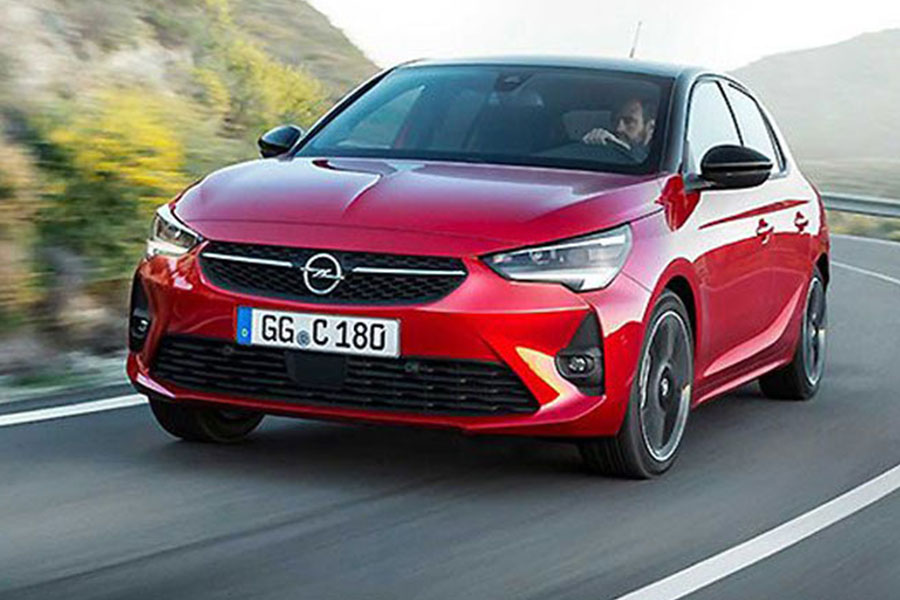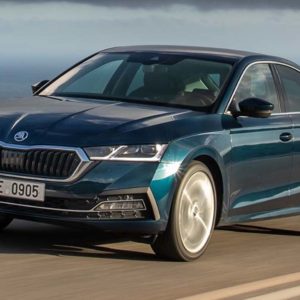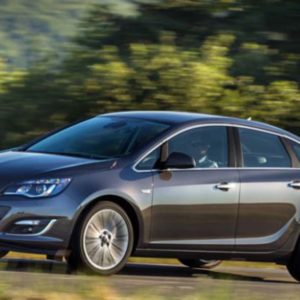The sixth generation of the Opel Corsa is in the fast lane. Just a few days after the presentation of the battery-electric version, Opel is now announcing the Corsa with classic combustion engines – more efficient, more advanced and more dynamic than ever. Sales of the 4.06-metre-long, five-door small car from the German carmaker start with particularly economical petrol and diesel engines featuring power outputs ranging from 55kW (75hp) to 96kW (130hp). Moderate fuel consumption and an engaging drive are characteristic of all powertrain options.
“The reaction to the presentation of the all-electric Corsa-e – an electric car for everyone -is phenomenal”, said Opel CEO Michael Lohscheller. “The Corsa with classic combustion engines will follow in its wheel tracks. Combustion engine or electric drive? At Opel, thanks to the multi-energy platform, both are possible in one model. The customer decides.”
The gearbox range is topped by the eight-speed automatic transmission. The sporty overall impression is underlined by the lightweight design and the low seating position of the driver. In addition, passive safety is at a high level, while Opel’s engineers have also finely tuned the chassis and the steering. All these qualities are already offered by the base version. Equally convincing are the advanced assistance systems, innovative infotainment and an excellent price-performance ratio. The Corsa also makes a smooth eight-speed automatic transmission available for the first time in this segment. For this price, there has never been a more high-tech, dynamic Opel Corsa.
The new Opel Corsa can be ordered as of July 1, 2019 in Germany. The entry-level variant is priced at €13,990 (RRP including VAT in Germany). This already includes numerous assistance systems, such as front collision warning with automatic emergency braking and pedestrian detection as standard. In addition to the all-electric Corsa-e, diesel and petrol versions are available in three new equipment lines: as Edition for €15,850 in Germany (RRP including VAT), Elegance and especially sporty GS Line are also available.
New engines: Ideal balance between efficiency and performance
The sixth-generation Opel Corsa’s all-new engine portfolio aims to offer customers an ideal balance between efficiency and an engaging drive. Compared with the current power units, the new engines return significantly reduced fuel consumption and emissions while retaining similar power outputs.
The improvements begin straight away with the base 55kW (75hp) 1.2 – NEDC combined fuel consumption is 4.1 l/100km. This is a substantial improvement in comparison to the current 1.2 model with 51kW/70hp and its NEDC combined consumption of 5.9-5.6 l/100km and 134-128g/km CO2.
Higher performance is supplied by the award-winning, three-cylinder, direct-injection turbocharged engine family (Engine of the Year 2015-2018), also with 1.2-litres displacement. The all-aluminium engines produce 74kW (100hp) or 96kW (130hp). With the 74kW (100hp) engine, the new Opel Corsa needs 4.4-4.2 l/100km NEDC combined. The 1.4-litre predecessor, also with 74kW (100hp) consumed 5.8-5.4 l/100km combined according to NEDC (WLTP: 6.7-6.5 l/100km, 151-146g/km CO2). Even with the most powerful 96kW (130hp) version, which has no equivalent in the current Corsa range, the preliminary fuel consumption and emissions figures remain moderate.
Wide torque plateau for petrol engines: Top driveability
High efficiency and lively performance are characteristic of the new petrol engines. Internal friction and friction losses have been reduced to a minimum. The turbocharger also reacts immediately, with strong torque development already at low rpm. Maximum torque of the 74kW (100hp) 1.2 is 205Nm; the top 96kW (130hp) unit even develops 230Nm. With the majority of maximum torque available in a wide band, both engines are notable for their high driveability. At least 95 per cent of maximum torque is developed between 1,500 and 3,500rpm – in combination with the low vehicle weight, excellent aerodynamics and the optimised gear ratios, this enables very good driveability.
The improvement in efficiency through the engine range is reflected in the driving performance. While the new Corsa with 96kW (130hp) reaches a maximum speed of 208 km/h, its predecessor needed 15 per cent more power (110kW / 150hp) to get to 207km/h. With zero to 100km/h acceleration in 8.7 seconds, the new model is 0.2s quicker than its predecessor. Equally impressive is the 1.2 turbo with 74kW (100hp). With a top speed of 188km/h, it is 3.0km/h faster than the similarly powered predecessor. Depending on the gearbox, it also accelerates from zero to 100km/h in around 10.0 seconds – 1.0s quicker (all figures preliminary).
In addition to the engines, the powertrain improvements also include the transmissions.
- The 55kW (75hp) entry-level engine is fitted with a five-speed manual gearbox as standard.
- With the 74kW (100hp) unit, customers can choose from a six-speed manual or a smooth eight-speed automatic. Adaptive shift programmes and Quickshift-technology represent the state-of-the-art in the Opel Corsa’s market segment. Drivers can shift gears themselves via the paddles at the steering wheel.
- The top-of-the-line, 96kW (130hp) 1.2 Direct Injection Turbo is always combined with the eight-speed automatic transmission.
High-tech and high efficiency
The three petrol engines are joined by a lively 1.5-litre diesel with 75kW (102hp) and maximum torque of 250Nm.
For optimum exhaust after-treatment, the emissions reduction system – consisting of a passive oxidation catalyst/NOx adsorber, AdBlue injector, SCR catalyst and Diesel Particulate Filter (DPF) – is grouped together as a compact single unit, as near as possible to the engine. The NOx adsorber acts as a cold start catalyst, reducing NOx emissions at temperatures below the SCR light-off.
Fans of electric-mobility, of course, can order the Corsa-e. Thanks to the common modular platform (CMP), various powertrains can be offered on one platform.
Lean: lightest variant weighs less than 1,000kg
In addition to the new Opel Corsa’s lively engines, the lightweight design also contributes to the top driving dynamics. The lightest version of the next generation model even undercuts the magical 1,000-kilogramme mark. Excluding driver, the five-door weighs only 980kg. Compared with its predecessor, this model variant is a useful 108kg lighter. This is a weight-saving of around 10 per cent, although the new model has a similar length of 4.06 metres. The body-in-white is around 40kg lighter, the very compact three-cylinder engines weigh around 15kg less than the four-cylinder units of the previous generation. The aluminium bonnet also saves 2.4kg in comparison to the previous model’s smaller bonnet made of steel. The seats also have been put on a diet. The optimized seat structure saves another 10kg.
The new Opel Corsa conveys dynamics through its sporty design – especially in combination with the two-tone paintwork. The roof line is coupé-like, 48mm lower than the predecessor’s, without detriment to headroom for the driver and front passenger. The driver sits 28mm lower. Handling and driving dynamics benefit from the lower centre of gravity. The handling is responsive and dynamic, for more fun behind the steering wheel.
Democratisation of technology: advanced assistance systems and matrix light
In the new Opel Corsa, Opel offers technologies and assistance systems that customers otherwise only know from higher vehicle classes. A real highlight is the adaptive glare-free IntelliLux LED® matrix light, which Opel is making widely available for the first time in the small car segment. The eight LED elements are controlled by a high-resolution front camera of the latest generation and automatically and continuously adapt the light beam to the respective traffic situation and surroundings.
State-of-the-art assistance systems such as traffic sign recognition or the radar-based automatic cruise control, as well as the sensor-controlled flank protection, offer a noticeable safety bonus. The latter warns if the sides of the car risk making contact with obstacles (e.g. posts, walls) during manoeuvres at less than 10km/h. There are also systems such as side blind-spot assist and various parking aids, from park pilot to 180-degree panorama rear view camera. Lane keep assist is also making its Corsa-debut. If the system detects an unintended lane-change it alerts the driver with a flashing signal and a nudge of corrective steering.
Opel Corsa drivers and passengers are well connected and entertained with the new range of infotainment systems comprising Multimedia Radio, Multimedia Navi with 7.0-inch colour touchscreen and the top-of-the-line Multimedia Navi Pro with 10.0-inch colour touch screen. In addition, the Corsa also offers the new telematics service “Opel Connect” as option. Live navigation with real-time traffic information and current fuel prices, plus a direct link to breakdown assistance and emergency calls make journeys even more relaxing for drivers and passengers.
Take your pick: extremely sporty Opel Corsa GS Line, comfortable Corsa Elegance
The new Opel Corsa is offered in four trim levels. Even the entry-level version has many technologies and comfort-enhancing extras, such as typical Opel features like steering wheel heating and heated leather seats with massage function for the driver. The assistance systems include, for example, front collision warning, intelligent cruise control, lane keep assist and speed sign recognition. Above the base version, three equipment lines with different emphases address different customer groups. The Corsa Edition adds the most popular extras, the Corsa Elegance is trimmed for maximum comfort and the Opel Corsa GS Line combines additional sporty features. The equipment philosophy, which Opel is presenting for the first time with the Corsa, will soon also be available for other Opel models.
In the Opel Corsa Elegance (from €17,850 in Germany, RRP including VAT), a six-way adjustable front passenger seat, armrest with storage compartment as well as LED headlights in typical Opel-look and LED fog lights make journeys even more relaxed. Chrome decor, attractive stitching and other details make the Elegance especially attractive. The sporty ambitions of the GS Line as dynamic model variant are obvious – inside as well as out. Sport seats for driver and front passenger, as well as aluminium sport pedals, a black headliner and red décor on the instrument panel, underline the sporty feeling. The GS Line can be recognized immediately by a chrome tailpipe and sporty looking bumpers at the front and rear. A Sport mode delivers even more dynamic steering and throttle response. Prices for the Opel Corsa GS Line start from €19,880 in Germany (RRP including VAT). Further design highlights include B pillars in high-gloss black as well as a variety of personalization options. This includes a comprehensive wheel programme as well as a fully digital cockpit, leather seats or two-tone paint.



